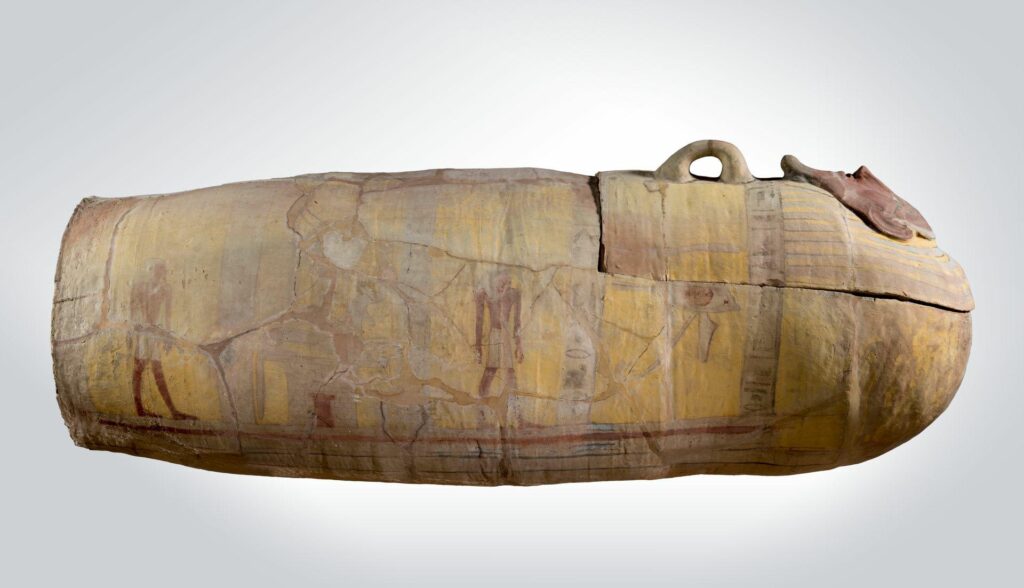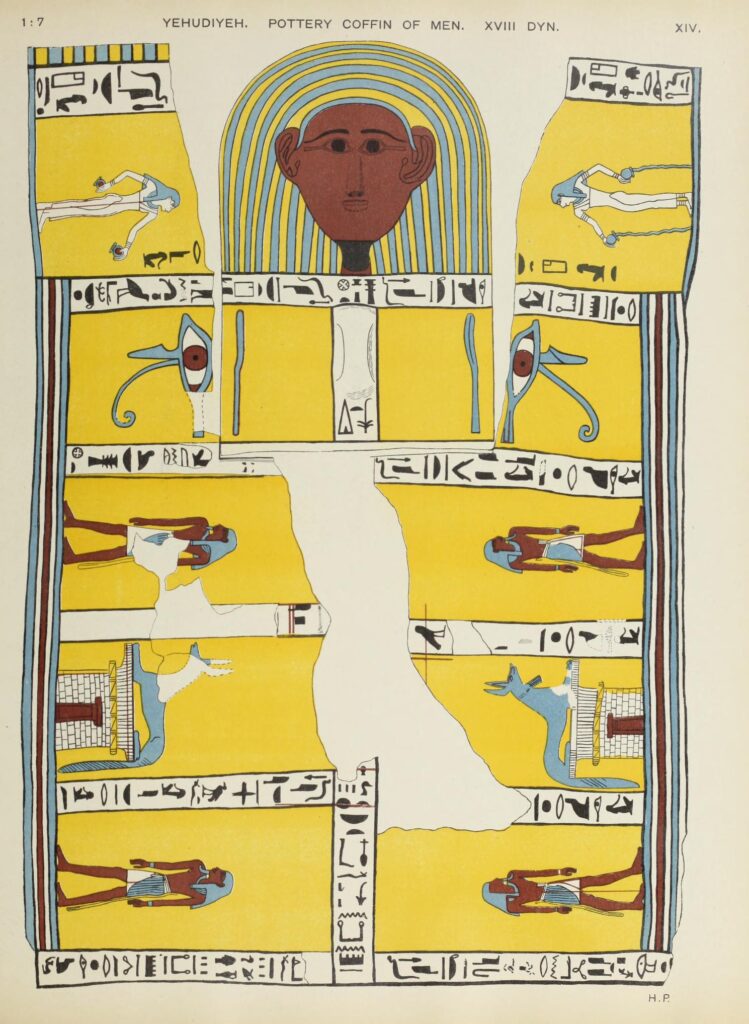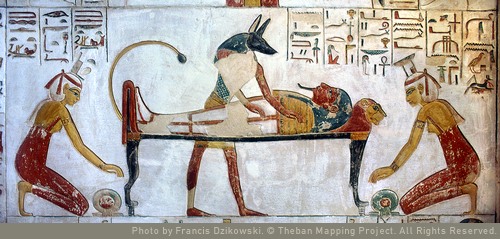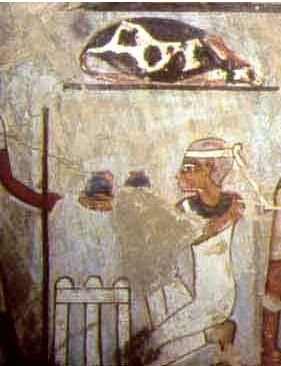
Coffins in Ancient Egypt were not made just in wood, but also in ceramic. Although these kind of coffins are much more common in the Middle East, there are some examples coming from the northeast of Egyptian Delta.
Let us pay attention to the clay coffin of Men (Musées Royaux d’Art et d’Histoire de Bruxelles, E.04348), belonging to the Dynasty XVIII and from in Tell el-Yahoudiyeh (tomb 411), ca. thirty mile northeast of Cairo.
This clay coffin belongs to the called “group B”, that is, with cylindrical shape and the head and shoulder not defined.
External Decoration.
Its exterior decoration and inscriptions draws the attention of this coffin. Its iconography, altough typical of Ancient Egypt, makes this artefact very special; the wig, ending suddenly over the inscription, the lack of wesekh– collar, something that essential for a corpse.
However, Men, the dead, was not unprotected. The exterior iconography of the coffin shows images, which helped the mummy in getting the eternal life. No one is gratuitous and the whole composition is connected with this idea of regeneration so typical of Ancient Egypt.
Lower Part.
At the feet, right and left, were the four Sons of Horus (in anthropoid shape): Amset, Hapy, Duamutef and Qebehsenuef. These four deities were very important for the corpse, because they also were the guardians of some organs of the mummy (contained into the canopic jars). In addition, everyone was related to one Cardinal point:
| Son of Horus | Organ | Cardinal Point |
| Amset | Liver | South |
| Hapy | Lungs | North |
| Duamutef | Stomach | East |
| Qebehsenuef | Intestine | West |
They protected therefore the dead physically (his viscera) and geographically (through every Cardinal point).
Two images of Anubis, as the jackal Lord of the Necropolis, were interspersed with the depictions of the Four Sons of Horus. Always as an allusion to the burial place.
Middle Part.
Going up the body of the coffin the next, apparently simple, but very important image is two depictions of the Udjat Eye, the Eye of Horus.
It was an Ancient Egyptian image of the full moon and in the funerary sphere it symbolised the complete resurrection of the dead. In the Osiris myth, once the Eye of Horus was completed Osiris achieved the resurrection and became king of the Underworld. O earth that though was applied also to the mummy through the funerary ritual of the Opening of the Mouth Ceremony. At the end of it, the Eye of Horus was symbolically completed and the mummy (assimilated to Osiris) achieved his final resurrection.
In the clay coffin of Men we can see two Udjat eyes at right and left evoking the god Osiris. The god, according to the inscription, talks “for the ka of Men true of voice”, an epithet of the dead and resurrected.

Upper Part.
At the top and at both sides of the head are Isis and Nephthys. This is another crucial image in the belief of Ancient Egypt for helping in the dead’s resurrection because these two goddesses played an essential role in the Osiris’ regeneration. Isis and Nephthys were their mourners and during that lament, they made a performance, which contributed to the recovering of the corpse.
In funerals of Ancient Egypt two professional mourners in the role of Isis and Nephthys played a mourning rite during the Opening of the Mouth Ceremony (more info). At the end of it the dead was supposed to resurrect and achieve the eternity.
Obviously, this had to have its place in the funerary iconography, so the artist(s) did not doubt in including it in the clay coffin of Men. Isis, at the right side of the head, holds with every hand a shen ring, and Nephthys, at the left side of the head, is pouring liquid from two nw vases.

Both gestures are related to resurrection; the shen ring, the circle with no ending, is a well-known symbol of eternity in Ancient Egypt. It appears constantly in funerary decoration and especially in connection with Isis and Nephthys. Usually both goddesses are depicted at both ends of sarcophagi and coffins with or next to a shen ring.
The nw vases are also closely related to the mortuary sphere and Isis and Nephthys. At the end of the funerals, when the mourning rite and the Opening of the Mouth Ceremony had finished, the two professional mourners appear making an offer of the two nw vases. They contained make-up, which symbolised the recovery of the Udjat Eye, the full moon, the resurrection (more info).

Therefore, according to the belief of Ancient Egypt, every icon of the coffin was chosen to assure the Men’s resurrection.
The following question is there was a strategic location of every image in the exterior decoration of the coffin.
In the next post…
Trackbacks/Pingbacks